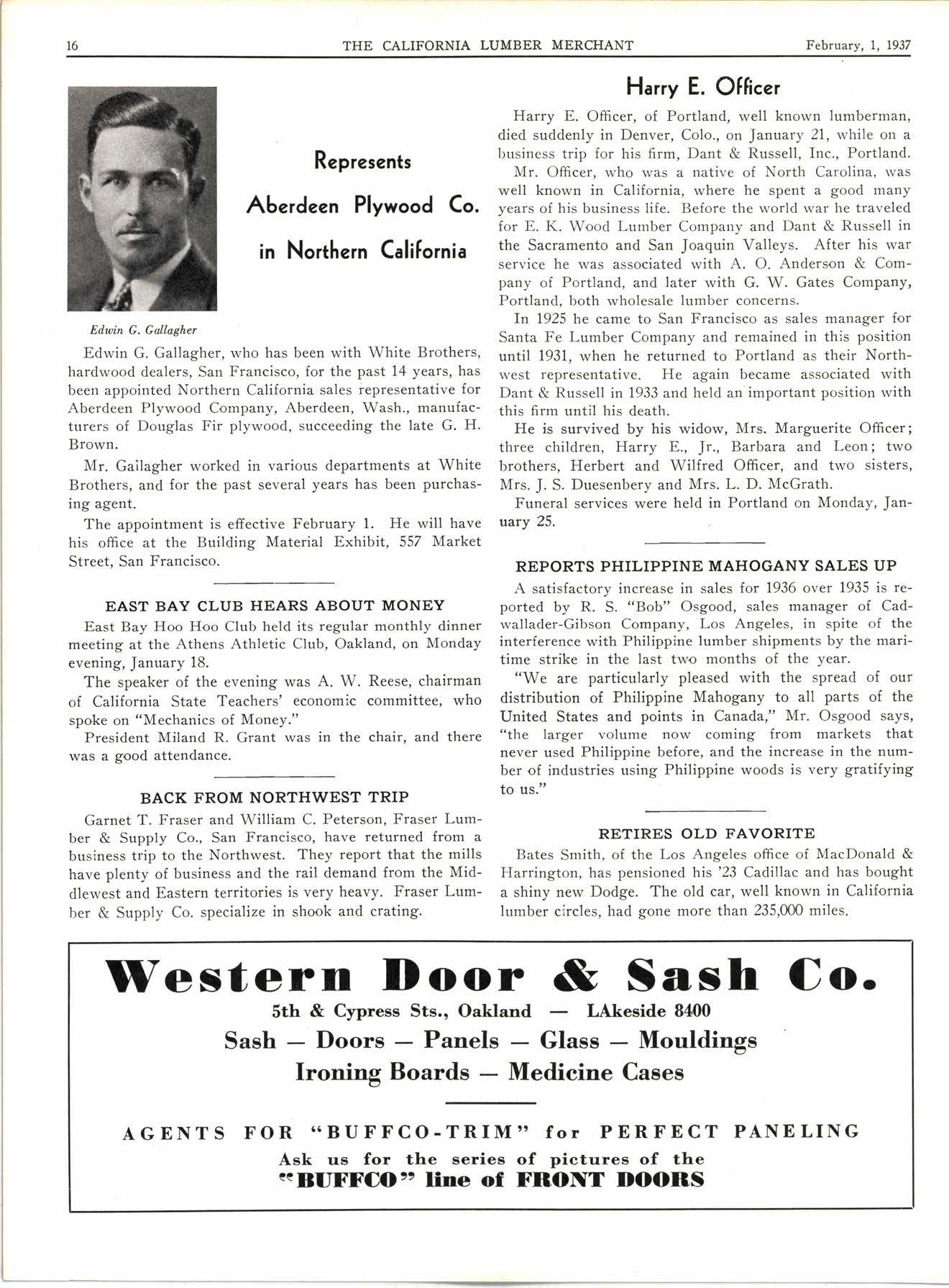
4 minute read
The Lumber Industry of the Douglas Fir Region for 1936 and the Outlook for 1937
Bv Col. \(/. B. Greeley,'secretary-Manager, \ilest Coast Lumbermen's Association
For the third year in a row, the lumber industry of the eign and domestic lumber markets served by water because Douglas fir region in Western Washington and Oregon has of labor disturbances. The lumber industry in British been prevented by serious labor disturbances from taking Columbia operated full time during the two years. advantage of better marketing conditions. In 1934 the in- For this year to date, British Columbia mills have redustry along the Coast was closed more than 80 days by ported 65.11 per cent of the total North Pacific Coast shipthe longshore strike; the 1935 lumber strike closed the ments to outside foreign markets compared to 19.85 per cent Western Washington industry down for more than 4O in 1929. The American mills supplied 8O.18 per cent of the days; since the first of November, t936 the waterfront mills shipments in L9D to these markets and but 35.89 per cent in have been either closed or on greatly reduced schedules due 1936. The share of the American mills has decreased each to the marine closure. While these stoppages due to labor year since l9D. Through the preferential agreements withtroubles have cost important parts of the industry, the in the countries of the British Empire, British Columbia afiected employees, and communities millions of dollars in mills have increased their production of these markets from lost sales and payrolls, the industry as a whole made prog- 2ll per cent in 7929 to more than 9O per cent this year. ress toward prosperity in both 1935 and 1936.
The total production of lumber in the Douglas fir region during 1936, with the last two weeks still to be reported by mills, is estimated by the Association to be approximately 6,340,000,000 board feet. This is an increase of 34 per cent over the total in 1935 of 4,700,000,00O feet. However, the 1936 production will be approximately 38 per cent less than the 10,400,000,000 feet cut in 1929. Other lumber regions within the United States and in Canada are expected this year, as in 1935, to reach production levels closer to L9D than is the industry of the Douglas fir region. But for the marine shutdown, which closed water markets normally taking 6O per cent of the industry's production during November and December, the Association estlmates the production for the year would have been approximately 6,7ffi,000.000 board feet.
Foreign Trade
Fore;gn trade in lumber from the Pacific Coast of North America, based on reports of the Pacific Lumber Inspection Bureau for 11 months, is expected to show an increase of from 150 to 170 million board feet over the volume shipped in the year 1935, but practically all the gains so far have gone to the mills in British Columbia. The Canadian mills shipped 797,965,0@ board feet to outside foreign markets in the 12 months of 1935 and929,675,000 board feet in the first ll months of 1936. In addition, British Columbia mills shipped 1.43,467,W feet of fir and hemlock into the United States to the close of November this year. Combined, these make a grand total of foreign and American shipments for the 11 months of 1,O73,142.000 board feet, which is more than the total water movement offshore and to the United States from British Columbia inl9D. The total water shipments from British Columbia for the year should be not less than 1,150,000,000 board feet.
The Oregon and Washington mills shipped 554,131,000 board feet abroad in 1935 and 576,267,0@ board feet foreign in the first 11 months of 1936. As shipments could not be made during December, this is likely to be the final figure for the year.
In both 1935 and 1936 the mills on the American side of the line were forced, for considerable periods, out of for-
Domestic Markets
American consumption of lumber in 1936, including exports, according to estimates of the United States Department of Commerce, will be approximately 22,427,W,ffi board feet. This compares with 18,235,000,0@ feet in 1935, and 13,105,000,00O feet in t932, which was the lowest year of the depression. The normal consumption for several years prior to the depression was between 35 and 36 billion feet.
Imports of foreign lumber into the United States are estimated on Department of Commerce reports to reach 64/m,ffi board feet in 1936 compared to 407,00O,000 feet in 1935. The increase is largely from Canada under the provisions of the Canadian Trade Agreement.
Residential construction, which normaliy accounts for around 6O per cent of the national lumber consumption, revived during 1936 to become an important factor in stimulating lumber production and sales. Building permit totals for the year to date are more than twice those of last year and should be at least $750,000,000 in total volume for the 12 months. Building activities of all kinds have been much in evidence throughout the country and have greatly stimulated lumber production. Approximately 200,00O family dwelling units were built in 1936. The Federal Housing Administration forecasts 400,000 in 1937.
The outlook for national lumber industry during 1937 is excellent. Production and sales are likely, from all indications, to climb back to two-thirds of the totals of 1928 and l9D levels. I{owever, a return of prosperity to the waterfront mills along the Puget Sound, Grays Harbor, Willapa Harbor, the Columbia river and the Oregon Coast cannot be anticipated until the present uncertainties in labor relations are in some way removed. Lumbermen can forecast a profitable and busy year for the mills in the interior of the Northwest; but for the area bordering the waterfront in Washington and Oregon wherein is located the bulk of the Douglas fir production, after the experience of the past three years, forecasting is impossible. Yet this region pays the highest lumber wages in the world and furnishes conditions of employment unequalled elsewhere.
A. I. Koll









